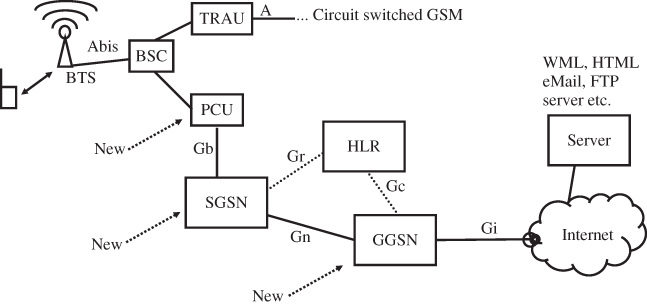2.5 GPRS Network Elements
As discussed in the previous paragraphs, GPRS works in a very different way compared to the circuit-switched GSM network. This is why three new network components were introduced into the mobile network and software updates had to be made for some of the existing components. Figure 2.16 gives an overview of the components of a GPRS network, which are described in more detail below.
Figure 2.16 GPRS network nodes.

2.5.1 The Packet Control Unit (PCU)
The BSC has been designed to switch 16 kbit/s circuit-switched channels between the MSC and the subscribers. It is also responsible for the handover decisions for those calls. As GPRS subscribers no longer have a dedicated connection to the network, the BSC and its switching matrix are not suited to handle packet-switched GPRS traffic. Therefore, this task has been assigned to a new network component, the PCU. The PCU is the packet-switched counterpart of the BSC and fulfills the following tasks:
- assignment of timeslots to subscribers in the uplink direction when requested for by the mobile device via the RACH or the PRACH;
- assignment of timeslots to subscribers in the downlink direction for data arriving from the core network;
- flow control of data in the uplink and downlink directions and prioritization of traffic;
- error checking and retransmission of lost or faulty frames;
- subscriber paging;
- supervising ...
Get From GSM to LTE: An Introduction to Mobile Networks and Mobile Broadband now with the O’Reilly learning platform.
O’Reilly members experience books, live events, courses curated by job role, and more from O’Reilly and nearly 200 top publishers.

